I have something of a bag obsession. I know all sorts of specs and fabric details for so many bags from so many random companies, and finding a bag that manages to distinguish itself from the masses is always a cause for celebration. This is why I was so annoyed that no one had ever told me about Tom Bihn, because it seems like all their bags do that, and they’re practically down the street from me.
One of their flagship travel bags is the Aeronaut, which is designed to be the only travel bag you need, and one you can take with you on any flight, or check through without worrying; a duffel bag that can be carried multiple ways, and can be organized far more efficiently than pretty much any other duffel bag out there. I included it on my list of travel backpack recommendations, and now that I’ve got my hands on one (Tom Bihn sent me a free sample to test out), we’re going to enjoy a super thorough review.
So here we go, with the Tom Bihn Aeronaut 30:
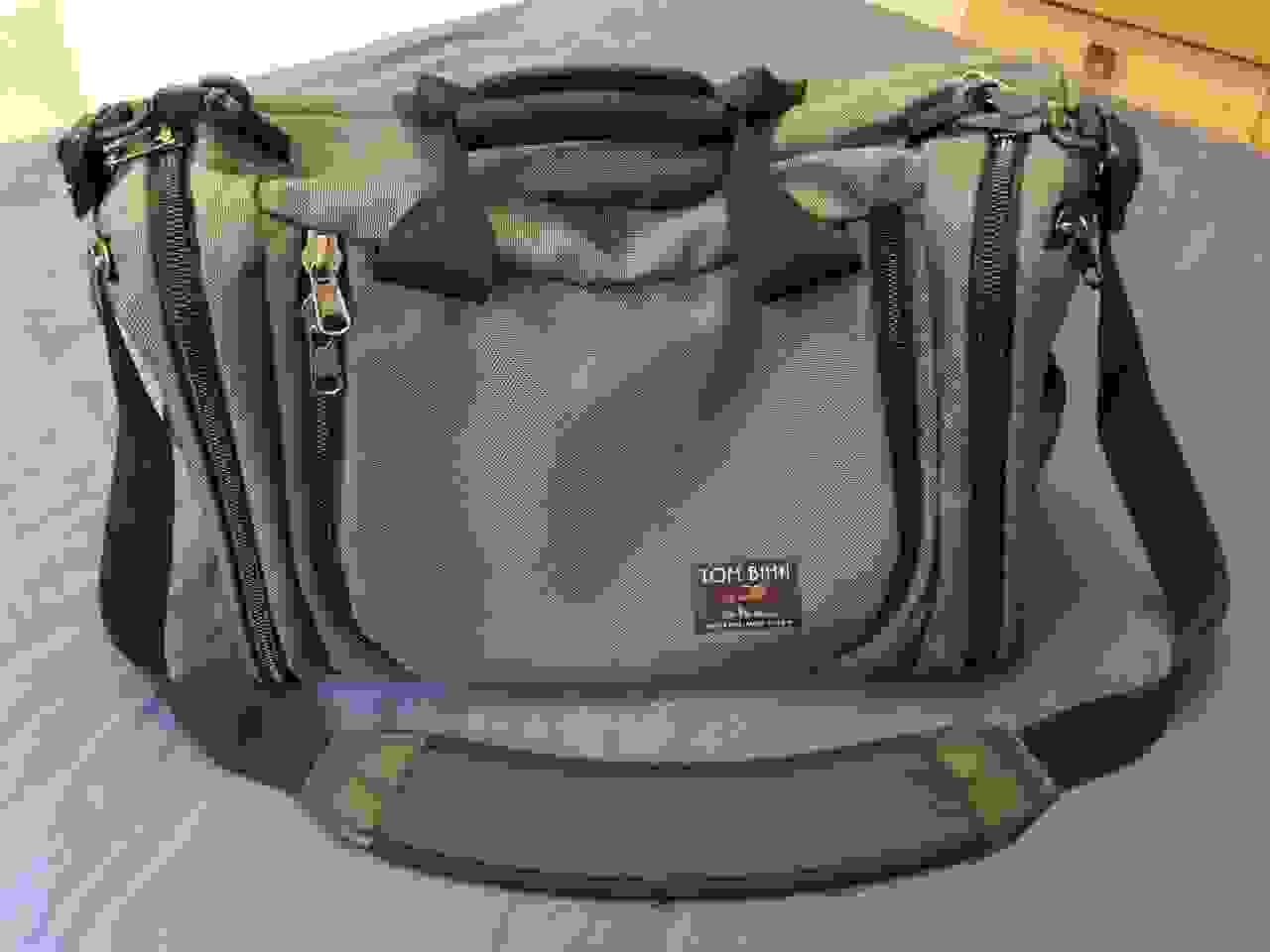
It’s a highly versatile, convertible duffel bag, going back and forth between duffel bag and backpack mode, and optimized for air travel, but useful for all sorts of other things as well.
Specs:
The Aeronaut comes in two different sizes; 30 liters, or 45. The 45 liter version was the original variation, designed to fit the maximum-sized carry-on dimensions of most major airlines, whereas the 30 liter version is designed to accommodate the more stringent requirements of smaller, no-frills European carriers.
I would expect that most…normal people will prefer to travel with the 45 liter version, as it simply provides more capacity, and, due to the compartmentalized design, is also easy to under-pack, as we shall discuss shortly…although the 30 is great if you just want a smaller bag for whatever reason.
Specs for the Aeronaut 30:
- Price: $270
- Capacity: 30 liters
- Dimensions: 19.7 x 12.6 x 7.9 inches (500 x 320 x 201 mm)
- Weight: 2 lbs, 14 oz (1.3 kg) for the ballistic nylon version, or 2 lbs, 5.6 oz (1.06 kg) for the Dyneema version.
Specs for the Aeronaut 45:
- Price: $280
- Capacity: 45 liters
- Dimensions: 22 x 14 x 9 inches (555 x 355 x 230 mm)
- Weight: 3 lbs, 1 oz (1.39 kg) for the ballistic nylon version, or 2 lbs, 7 oz (1.09 kg) for the Dyneema version.
(Both versions have exactly the same set of features; one is just the big brother version of the other, so although this review will specifically show the 30 liter version, the info is applicable to both.)
Comparing perhaps the best travel duffel bag…with the worst
For a while I had trouble thinking about how best to approach this, as the design is so self-explanatory that it seemed almost superfluous to discuss its oh-so-obvious features; but there are just so many minor details, many of which might be entirely overlooked, and under-appreciated…until you try something else, in which case the Aeronaut’s advantages would become immediately apparent.
So, instead of comparing the Aeronaut to a list of well-crafted contenders (almost all of which suffer from the same design problems anyway), I am instead going to conduct a side-by-side comparison with another duffel bag I own, which, as I’m sure you’ll agree, is the worst duffel bag in the history of the world:

This is, ironically, my oldest possession. I received it as a gift at the age of 13, and nothing else I own even comes close to matching the numerous chapters of my existence that this ancient survivor has overseen. Not because it’s good, mind you; it’s terrible. I brought it into the Tom Bihn factory to show them just how much of an upgrade I was getting. But it’s just another bag, so it comes in handy whenever I have to move, so there’s no reason to throw it out. Besides, it has my name embroidered on it. That makes for awkward gifting.
Of course, it’s clearly unfair to compare a high-quality duffel bag with a terrible one; we all know who’s going to win. But the design features of the terrible duffel bag are so frighteningly common in 99% of designs that comparing them directly against each other is going to highlight just how problematic those decisions can be, especially for air travel, which is something the vast majority of duffel bags are simply not properly designed to handle…particularly when it comes to qualifying as a carry-on.
It often helps to study a broken system to understand how to do things correctly, so I intend this to be not just a review of what’s going on with the Aeronaut, but also a simultaneous critique of the vast majority of duffel bags, and their many, glaring, travel-related deficiencies, which will become immediately obvious when placed side by side with something better. Let’s begin:
Layout and organization
This is perhaps the most obvious feature; as you can see, the Aeronaut is split into multiple compartments, whereas most duffel bags have just a single zipper, servicing a massive, disorganized, cavernous interior:
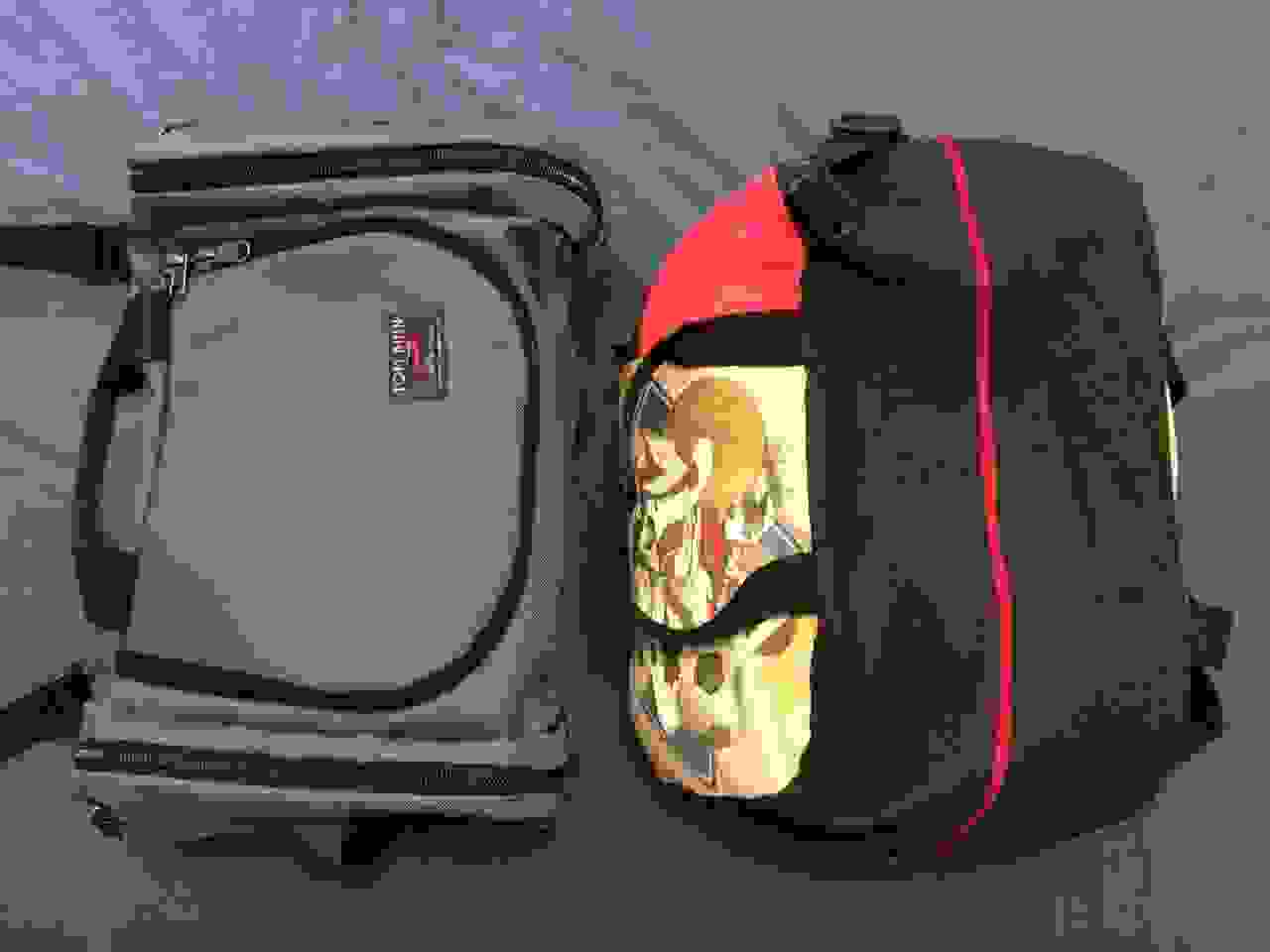
It’s pretty obvious that dividing the bag into multiple sections makes it a million times easier to stay organized, but it also makes it easier to under-pack (you can fill up just one or two sections without worrying about items banging around in the empty space, without the need for compression straps), and it makes it easier to pack to its maximum capacity (as the zippers go along multiple axes, and open more fully).
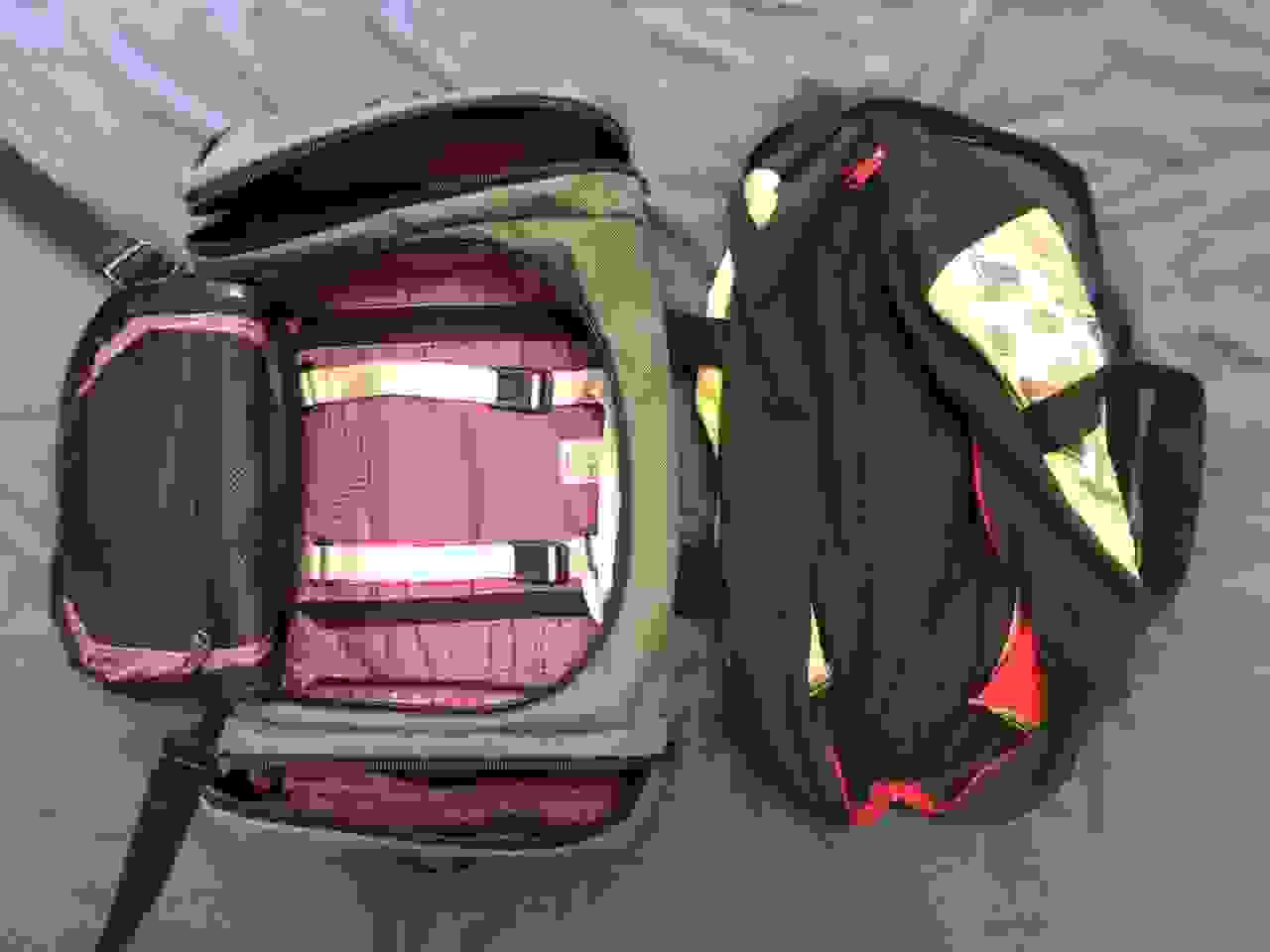
Trying to fill up a single-straight-line-zipper duffel bag to its maximum capacity is extremely difficult, because a standard duffel bag (when viewed from above) is rectangular, whereas the zipper opens in a diamond shape (because it’s a straight line stretched at the middle), which is exactly as annoying as it sounds. It’s also nearly impossible to find anything buried just a few inches deep without unpacking quite a few items, which can be rather annoying, due to the aforementioned diamond vs. rectangle issue. The more you have to pack and unpack, the more annoyed you’ll get…whereas the Aeronaut has none of these problems.
This is, however, a pros and cons scenario; a single zipper servicing the entire bag is easier to open and close quickly, as you just yank a single zipper in a straight line instead of opening multiple zippers with multiple angles; the speed is potentially helpful (and you can access it while standing), but then of course you have to live with the downside of poor organization, and the difficulties of packing and unpacking when you need to fill the bag to its maximum capacity. Single-straight-line-zipper duffel bags are at their best when they’re only partway full, with just a few bulky items, rather than lots of tiny ones.
But if you’re traveling, maximizing the use of space while simultaneously keeping things conveniently organized is the only way to go. There are going to be a million moments when you want to grab that one tiny thing, and digging around through a single, gigantic compartment is just going to drive you insane. And if you’re flying with strict luggage size limitations, “leave it half empty” just doesn’t work.
This is one of the major reasons why the Aeronaut functions as a really great duffel bag for air travel, as it allows for compartmentalized organization, efficient use of space, and easy packing and unpacking.
Here’s a closeup:
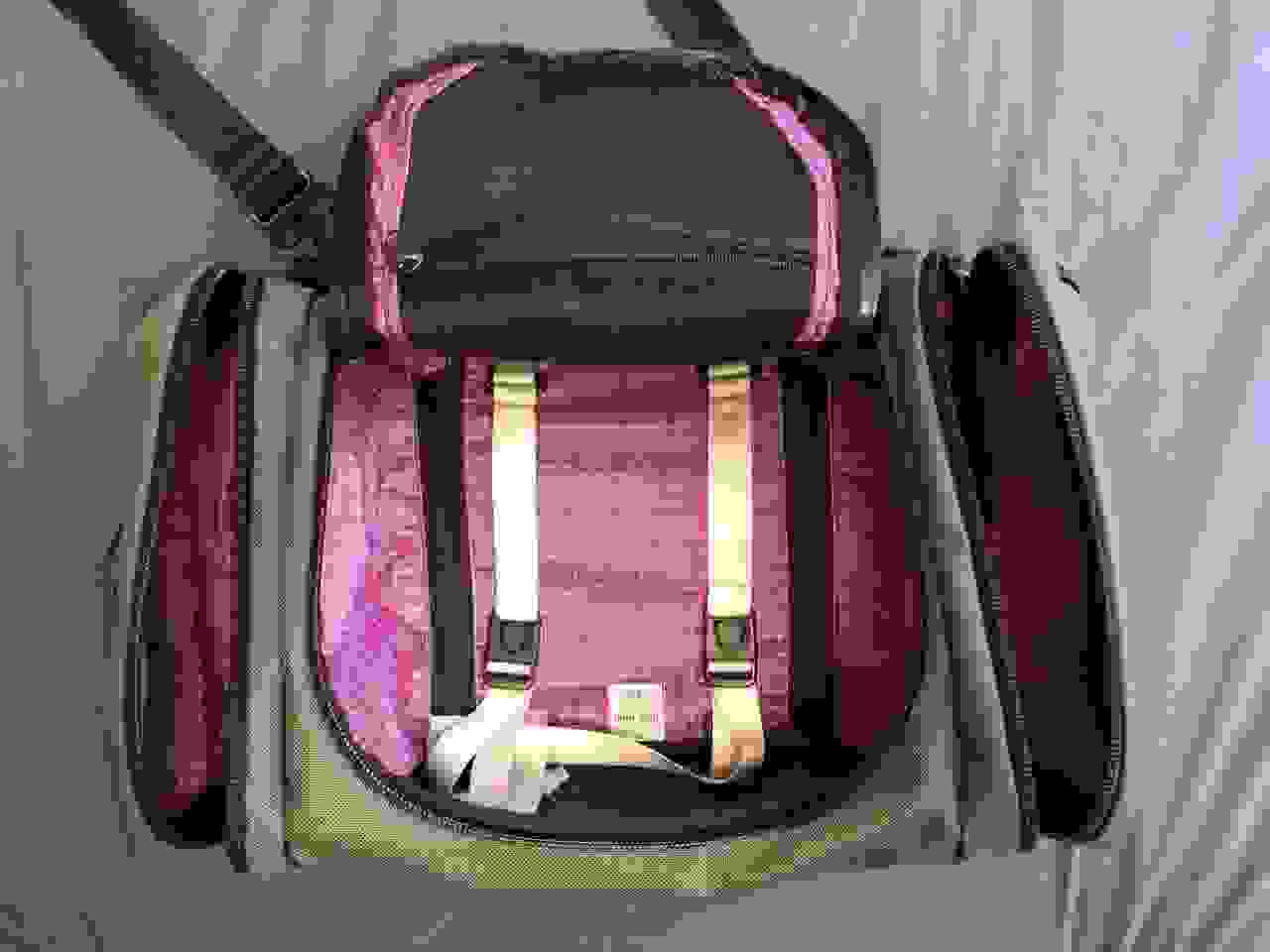
There are several things worth mentioning here; first of all, the ballistic nylon fabric and other elements actually provide some structure, so the bag doesn’t just flop over when it’s empty, so it’s easier to pack; secondly, the main flap barely takes up any room when open, whereas a standard suitcase door can be somewhat bulky if not propped up against a wall; thirdly, every one of those zippers is water-resistant, so you can haul it through the rain without much trouble.
On the inside, you’ll find some extra features, like the extra mesh pocket, and the (removable) straps that can be used to hold certain items in place, and the zippered divider walls that can be unzipped to turn the bag into a single, giant compartment, in case you need to carry something too long to fit into just the central chamber:
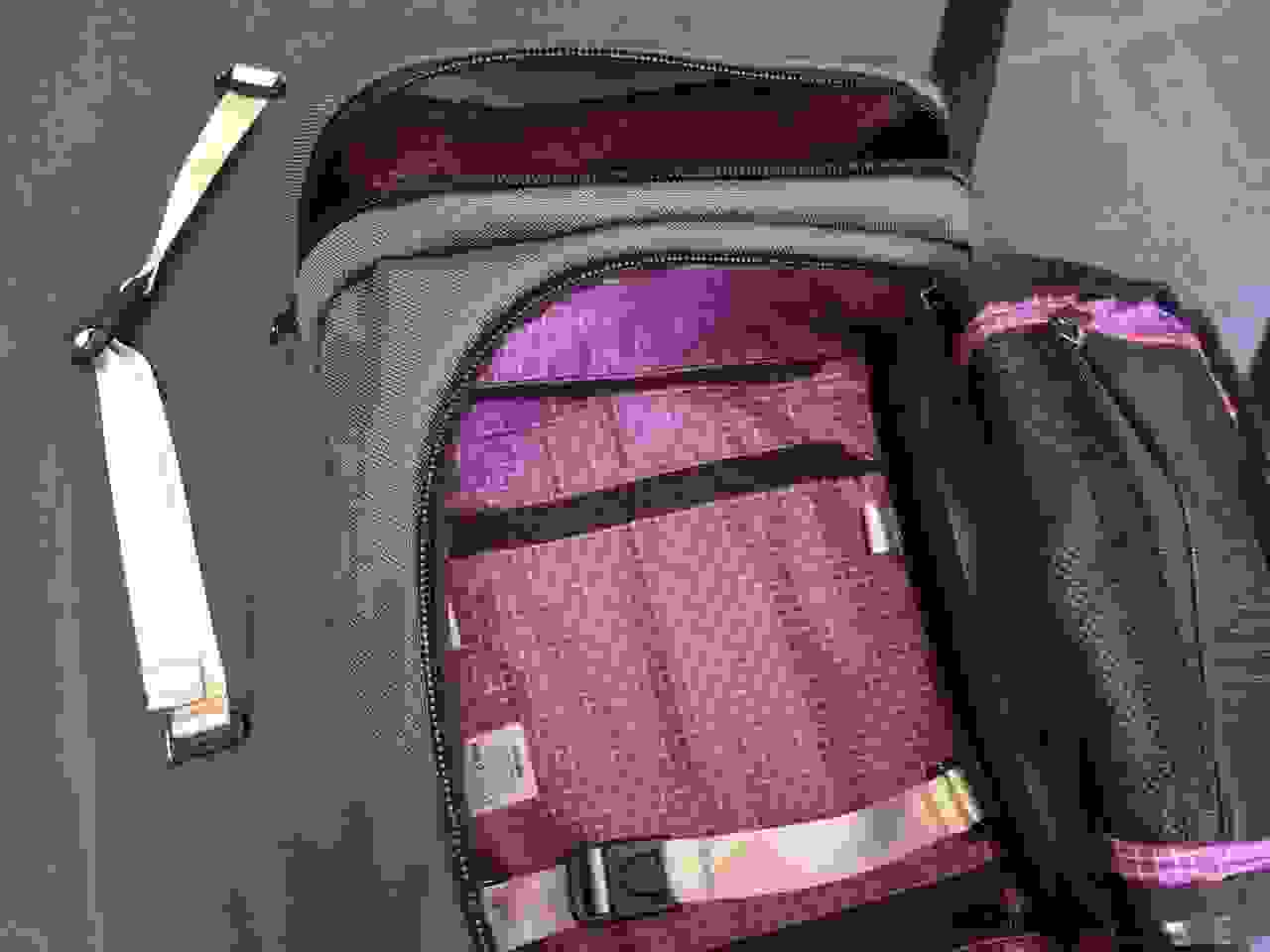
It doesn’t quite turn the bag into a single giant rectangle, though; it’s a bit more like a trapezoid. This is a bit difficult to describe, but it means you’ll still access the upper edges with those end-pocket zippers, rather than trying to get at them from the main zipper, which is offset far enough that it would get a little tricky at maximum capacity.
Speaking of end pockets, there’s an additional, zippered drop-in pocket on each end:
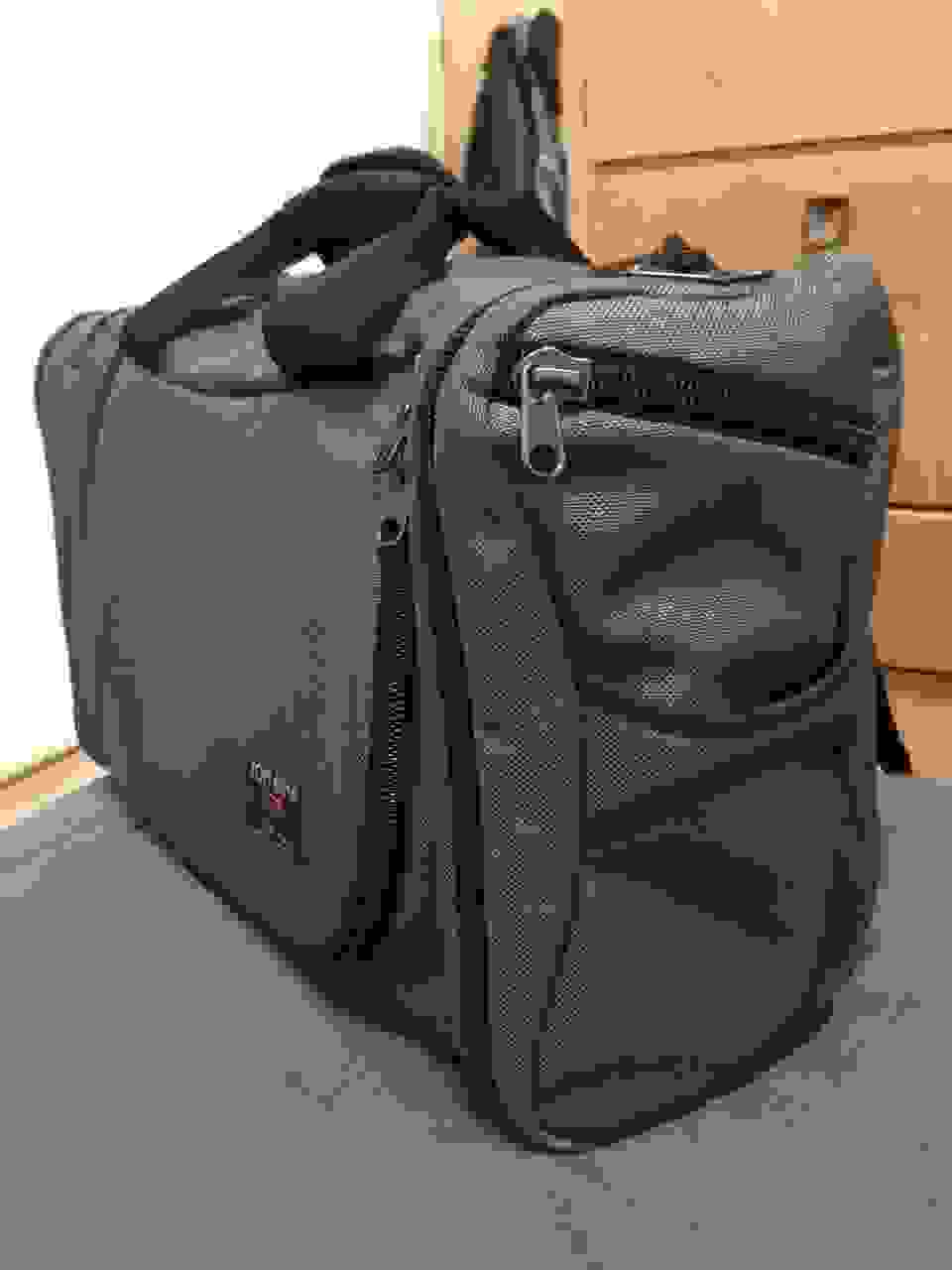
These end slots are good for long, skinny things that you might need quickly, like boarding passes, pens and pencils, or maybe a phone.
One of those slots also includes a removable key strap, for clipping all sorts of things into the bag:
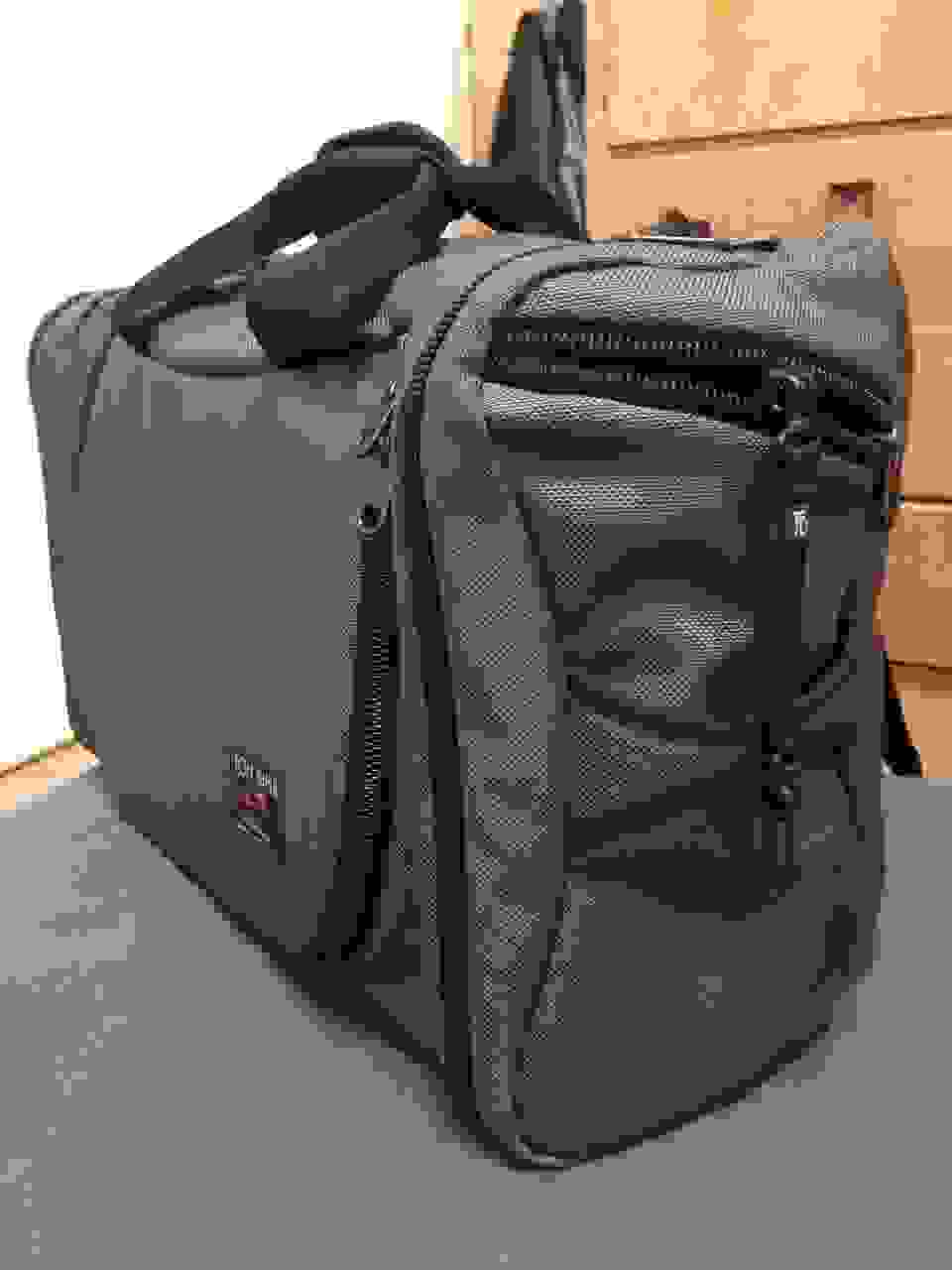
This is another reason Tom Bihn fans end up collecting the whole set; every bag has several attachment rings hidden among the compartments (I found nine in this bag), so you can clip tiny items all over the place. They never fall out, and they’re always exactly where you left them.
This is useful not just for small items like keys, but also other, smaller bags, such as the clear-sided 3-1-1 liquids container required by airlines, and other organizers. Just about every Tom Bihn bag is designed to work this way; the little bags clip into the big ones, and everything stays together. It’s quite convenient for keeping things from falling out and rolling under a bed in a hotel on the other side of the planet, for example.
Another major feature is simply the shape:
Air-travel optimized dimensions and features
Here’s another reason why the vast majority of duffel bags are terrible travel bags:

Most are either squared or cylindrical, which is simply not a good use of space in the overhead bin. They’re nowhere close to meeting carry-on dimension requirements, so you’ll probably have to check the bag, unless it’s incredibly small. And no matter how many times I’ve heard people complain about their bag not showing up when they arrive, they never bother attempting carry-on only travel…but oh well.
The Aeronaut, on the other hand, fits exactly within standard carry-on dimensions; the 45 liter version for major airlines, and the 30 liter version for smaller European budget carriers, meaning you’ll most often be able to bring it along with you. And, as far as I’m concerned, that’s the only way to travel.
And since you can stow it in the overhead bin, isn’t it convenient how it has those little grab handles on each end?

It’s not just easier to remove, but also easier to insert into the bin, because you’ve got something to hold onto as you shove it up there, so it’s harder for it to fall over.
Speaking of handles…
Multiple carrying options
This is a major strength of the Aeronaut, as it can be carried in three different ways, depending on how you want to handle things.
Main grab handle:
Take a good look at how the Aeronaut’s main handle compares to the obviously terrible, floppy straps of the other one:
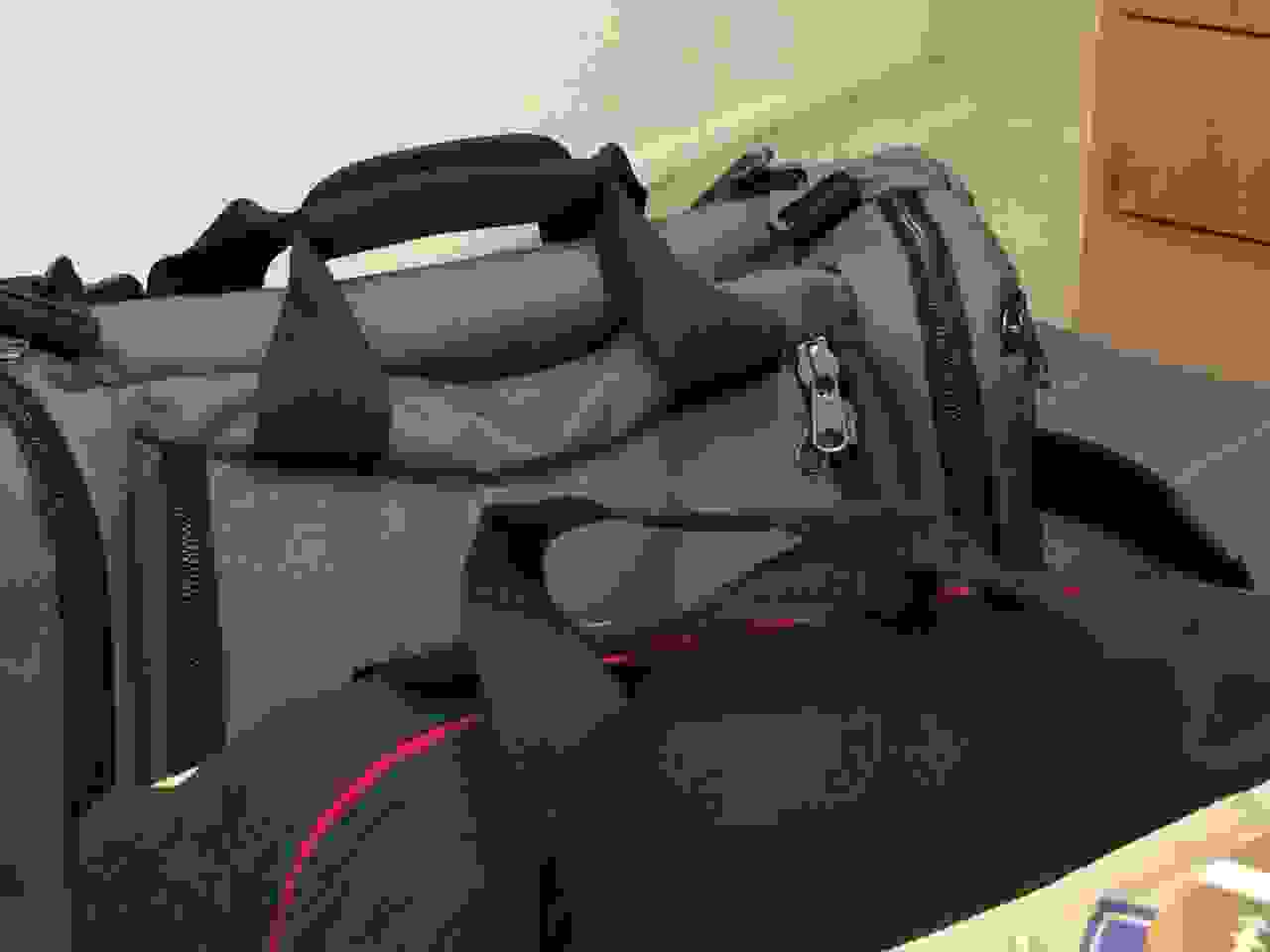
It’s so clearly superior as to be self-explanatory, but there are actually so many things worth mentioning here that I’m resorting to bullet points:
- It’s padded, making it more comfortable to carry, both in terms of cushioning and easy-to-hold size.
- It has a fixed shape (rather than the floppy straps of cheap bags), making it easier to grab, and more comfortable.
- The handle brings two separate straps together, making it a little more stable to carry; many other bags share this feature, but on the Aeronaut they snap together, so you don’t have to fumble with multiple floppy straps.
- The zippered main compartment is completely offset, meaning you never have to unsnap the main carrying handle in order to access any part of the bag. It’s just always together, always out of the way, and always ready to go.
Most other designs have two entirely separate handles which flop all over the place, and it sometimes becomes a two-handed operation to grab them (and imagine if your other hand is busy carrying another bag, or a small child). And even if they do snap or Velcro together, they’re quite often directly over the main zipper, meaning you have to unsnap them to access the bag, and then re-snap them when you’re ready to go. Or you could just leave them flopping around separately, but then you’re stuck with the first problem.
In contrast, the Aeronaut’s main grab handle is a lot easier to deal with, because you simply don’t deal with it. Life is just going to be a little easier, and when it comes to air travel, everything should be easier.
The shoulder strap:
Tom Bihn has a dearly-beloved, optional shoulder strap upgrade ($30 extra), known as the Absolute Shoulder Strap, which just about every review will recommend; it’s not included with the bag (it comes with a more conventional strap, with a sliding shoulder pad), but everyone adores it, especially when it comes to heavier bags, such as fully-loaded luggage that you’d take on a plane:
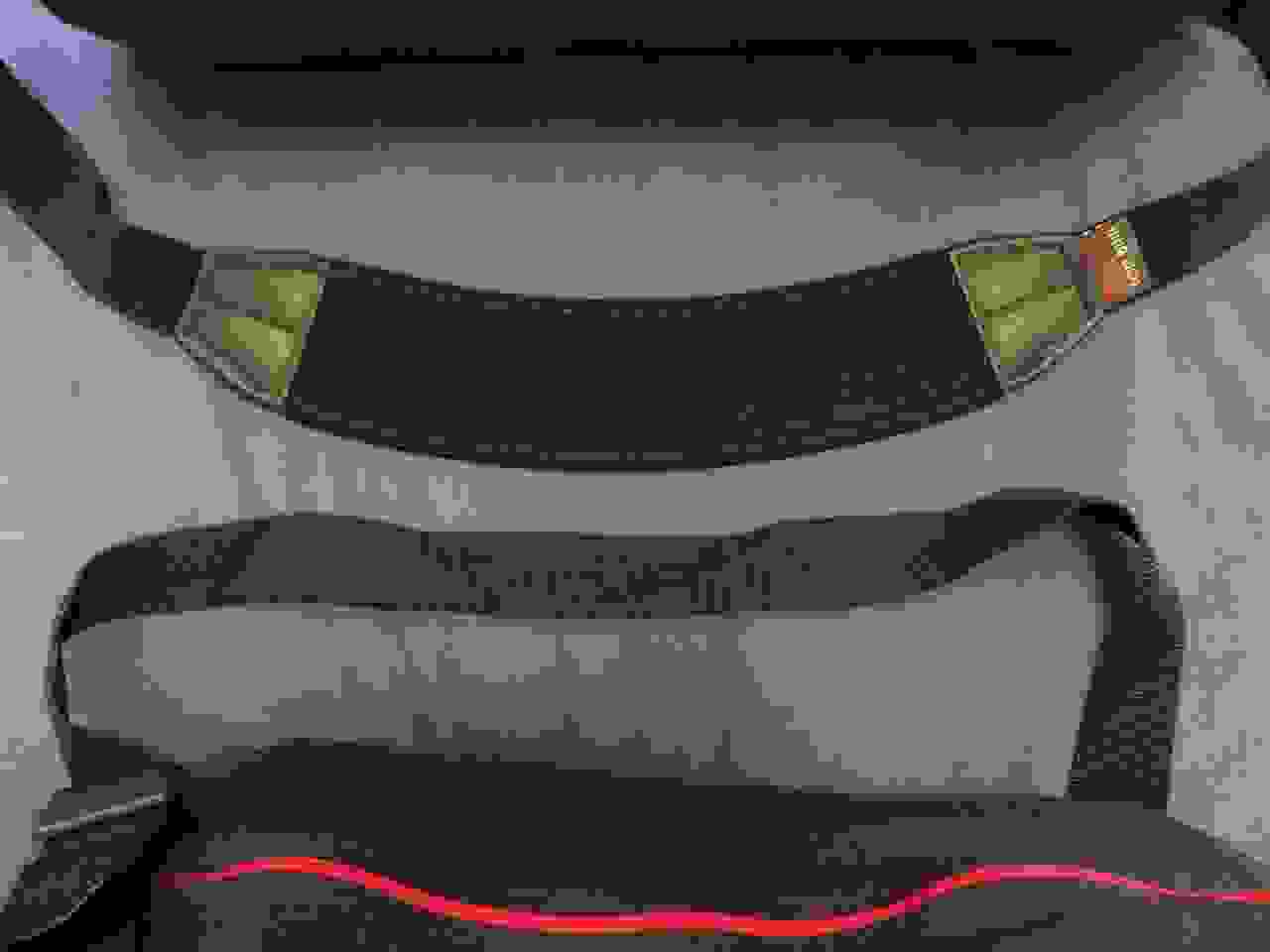
Bullet points again:
- It’s padded, which obviously makes it more comfortable.
- The padding is fixed into place (you adjust the strap length on each side, rather than just one), so you never have to slide the padding into position, which is something you have to do with most other straps. I love this particular feature.
- It has a grippy, non-slip surface on the side that rests against your shoulder, so it stays put.
- It’s curvy, meaning it’ll fit on your shoulder more appropriately than a straight strap.
- It’s actually stretchy. This is something I’ve never seen before, and I expect is a big part of the reason everyone loves this strap so much. Whenever you take a step and the bag bounces up and down, the stretchy shoulder strap works like a shock absorber, reducing the discomfort of carrying the bag over long distances (just be sure to adjust the strap when the bag is full, as the stretch makes it hang lower).
The strap is also long enough (at least on me) that I can adjust it to hang low enough that the grab handle is at the perfect height for hand-carrying, and thus I can distribute the weight between one shoulder and the opposite hand, to make it more comfortable to carry. Shortening the strap so you can loop your forearm through the main grab handle accomplishes the same thing, though I prefer the other way.
Backpack straps:
As mentioned, it can also convert to backpack mode. Here’s the back panel, where the backpack straps are hidden away when not in use:
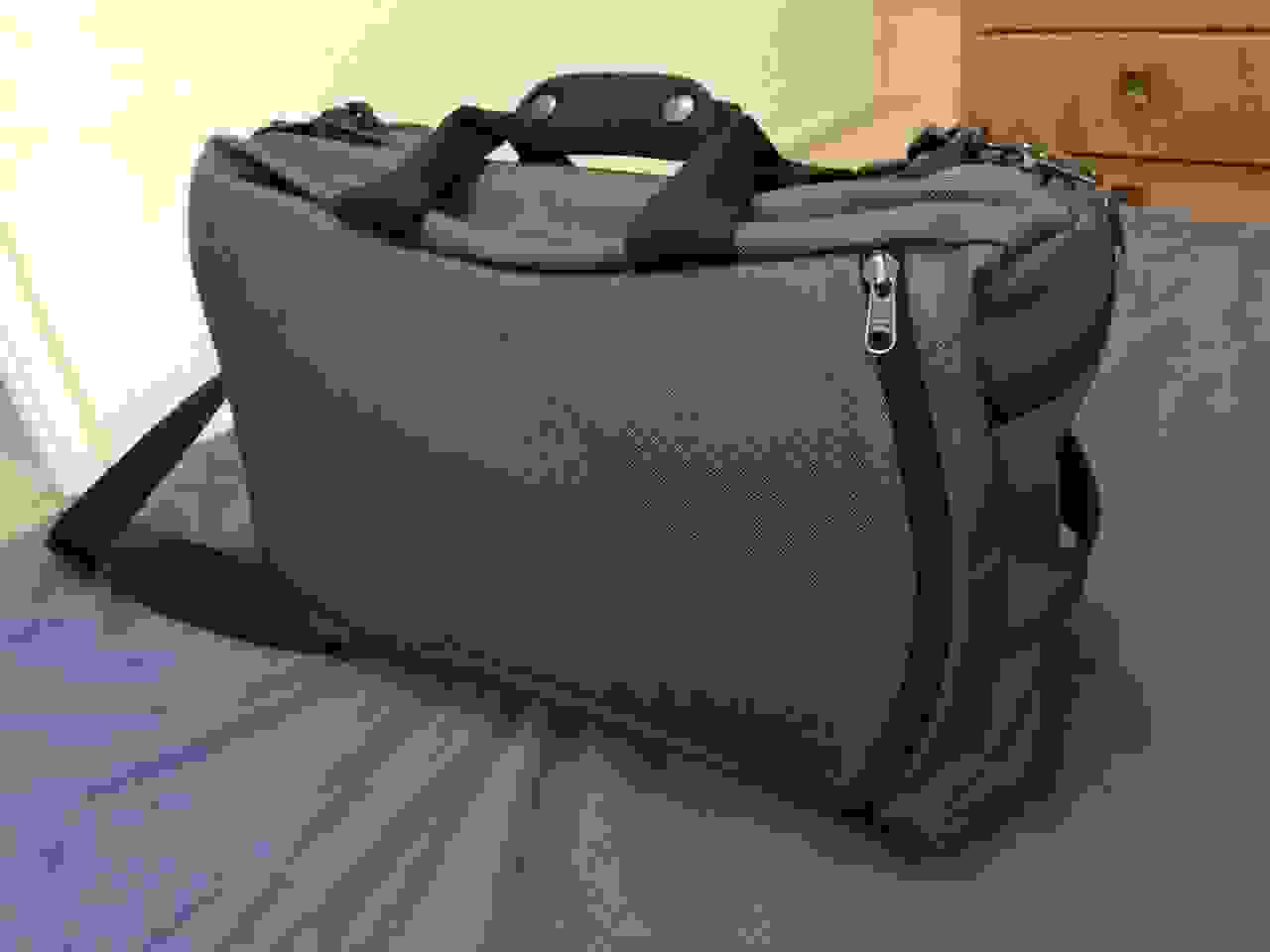
And here they are on the way out:
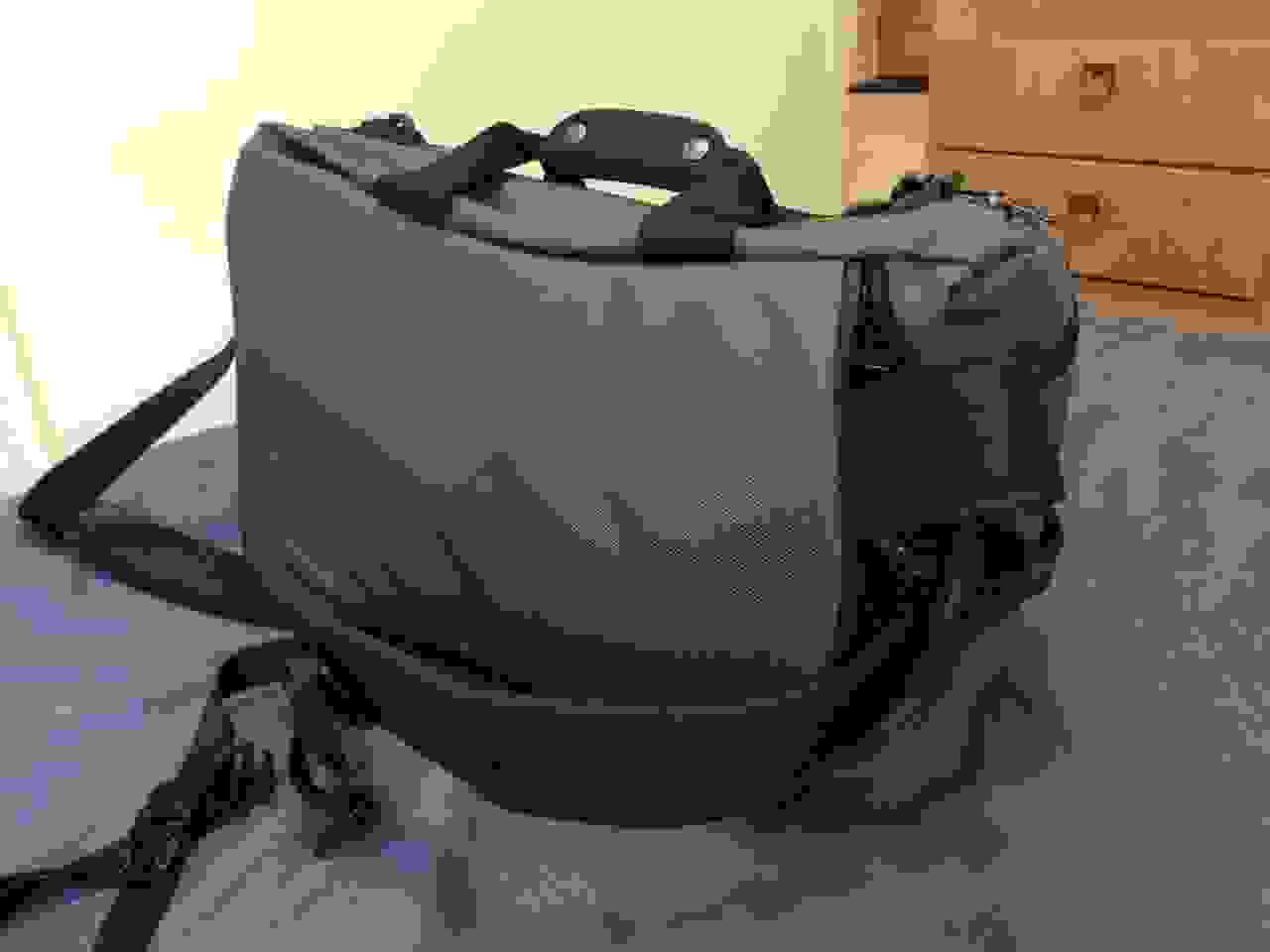
So it looks like this:
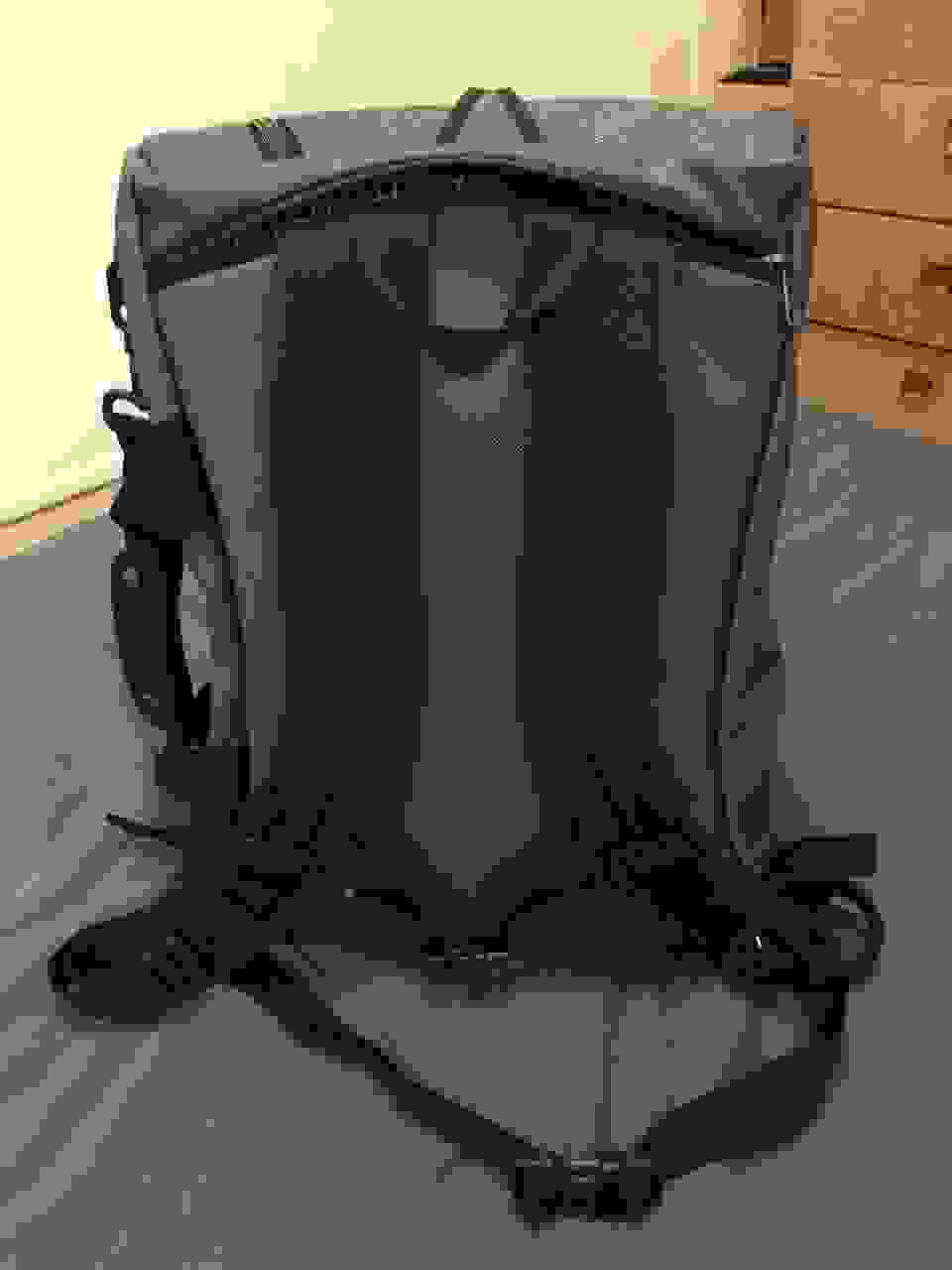
The backpack straps are identical to the ones used on their “real” backpacks, which I find quite comfortable, mainly due to the fact that they curve outward at the neck, rather than gouge into it, which is an oddly common problem with a lot of backpacks…even those with amazingly good reputations.
Another important thing to notice is that although the backrest is padded, it’s covered with the same fabric as the rest of the bag, rather than featuring visible mesh cushioning, like most “real” backpacks. This improves the aesthetics and durability, since there’s no exposed mesh to get snagged, but it’ll probably feel a little less breathable as a result, so it’s probably better to use them over shorter distances.
By the way, notice how you didn’t see the clips where the backpack straps attach; that’s because they’re completely hidden away in a recessed chamber:

Not only is this more aesthetically pleasing (to me, anyway), but it also means there won’t be any extraneous clips flopping around haphazardly to get stepped on, or banged around by other suitcases being shoved into the overhead bin, so it’s nice that they’re hiding like this; I’ve seen no other bags with this particular feature. But the clips are still easily accessible, as there’s plenty of room on either side of the clip to operate them. It’s a flat chamber, not a tiny one.
There’s another feature here that’s important; this is a closeup photo, so it’s hard to see what’s what, but it’s the waist strap (the horizontal one) clipping into a fabric loop that’s sewn directly into the backpack strap (the vertical one):
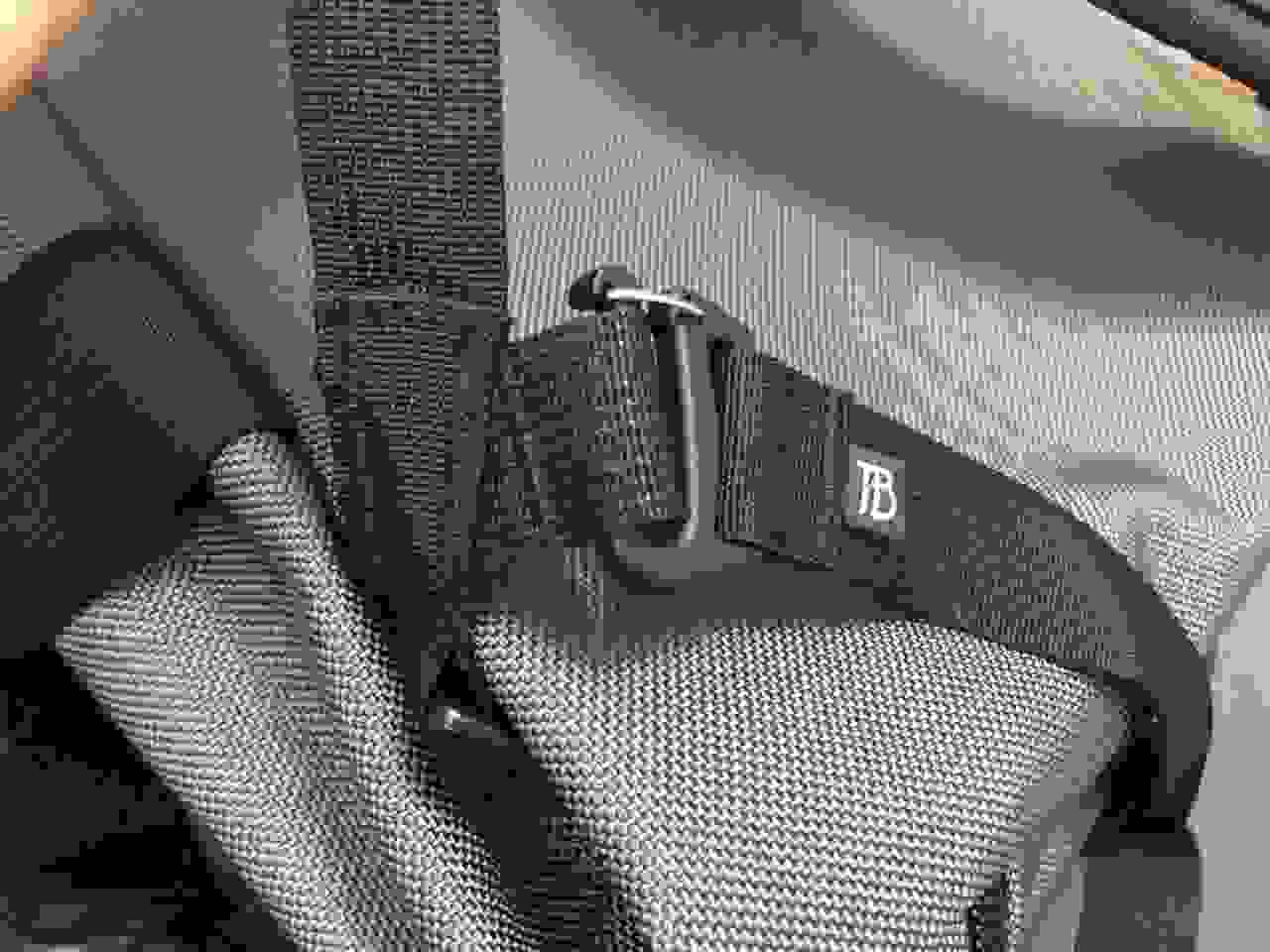
This means that when you stow or deploy the backpack straps, you still only have to deal with two clips, regardless of whether you’re using the waist strap or not; since the waist strap doesn’t have its own separate attachment point fixed to the exterior of the bag, it doesn’t require any additional steps, making it quick and easy to switch back and forth between backpack and duffel mode: Just one zipper, and two clips.
It does, however, mean the waist strap fits higher than on “real” backpacks; it’ll go over the stomach, instead of the waist (on me, anyway). It’s hard to say if this is objectively problematic or not, but I expect that taller people will think it’s sitting too high, whereas short people might think it’s fine. This might not even come up at all, as the waist strap isn’t even included with the bag anyway, and you might not even like using them, but it’s worth keeping in mind. I think it was the right decision on a bag like this, but it’s a compromise that favors speed and convenience over the ability to transfer some of the weight to the hips.
Carry method conclusions:
For a couple reasons, I would say that it’s best to think of the Aeronaut as a duffel bag first, and a backpack second; because the back panel is covered in fabric rather than leaving the mesh exposed, and the waist strap is fixed at a higher position, it’s likely that it won’t be as comfortable as a more standard backpack if you’re planning to cover long distances. They’ll work just fine while running through airport terminals and so on, but maybe not for wandering around town for an hour or two at a time. It just depends what sort of traveling you do, of course; I’d say it’s more suited to hotel and air travel, rather than hostel-hopping backpacker-style travel, which generally involves lots of walking.
And besides, it just looks like a duffel bag, and I like carrying it that way. The high-quality shoulder strap, grab handle, and easily-accessible end pockets are all optimized for duffel bag mode, and I would say that based on aesthetics as well as functionality, this is the best way to use it. Just think of the backpack straps as an added bonus, useful for airport terminal navigation, and other short distances, where the back panel and waist strap won’t gradually become problematic.
Slimmed-down profile
This is actually a huge deal, and one you might not even notice until you use the wrong one while walking over long distances in a bustling crowd:

Notice how far the other one sticks out, even though these two bags have approximately the same capacity. Now imagine walking through a crowded airport terminal, or walking down an airplane aisle, with limited space. You’re just going to bump into everything. And this is yet another reason why most duffel bags just aren’t that great in these situations. Not only is the square or cylinder shape problematic for overhead bin storage, but the weight is going to hang further away from your body, make you lean more crookedly to stay balanced, and it’ll smack into everything in sight.
The slim profile of the Aeronaut is obviously much more convenient, but it’s also the type of invisible feature you might not even notice, until you’ve spent time over on the dark side of improperly-proportioned alternatives.
The one feature that’s (potentially) missing
The Aeronaut has no dedicated laptop slot.
You can obviously just stick it in the main compartment, which is rectangular and will accommodate a laptop just fine; or you might be one of those people that prefers to travel with two separate bags, keeping the laptop in a smaller, secondary, under-the-seat backpack instead; or you might simply not care about laptops at all; or you could stick it in the chamber along with the backpack straps, which I’ve heard of some people doing.
Any of those solutions will work just fine, but this is the only feature I can imagine some people missing. It obviously has room for a laptop, but not a dedicated space.
By the way, if you’re looking to supplement this with a great daypack-sized laptop backpack that’s also nicely optimized for air travel, Tom Bihn’s Synapse is my pick (check out a review here).
Conclusions!
As you can tell, I consider this quite a thoroughly well-designed bag, specialized for frequent air travel, but useful for all sorts of other situations as well. Road trips, gym bag use, overnighters, and so on; it just also happens to fit nicely into the stringent world of airline carry-on requirements, while also offering some travel-friendly packing functionally, which sets it apart from oh-so-many alternate duffel bag options out there, 99% of which seem to have any or all of the problematic features listed above.
Good things:
- Carry-on dimensions make it a better travel duffel than anything squared or cylindrical, and it fits closer to the body, so carrying is easier.
- Multiple carrying options (shoulder bag, suitcase, or backpack), with an especially comfortable (optional upgrade) shoulder strap, and a great grab handle that’s out of the way of any zipper.
- Compartmentalized design offers great organization, easy access without digging through a giant cavern, and easy under-packing ability.
- Internal features such as straps, clips, and zippers offer some additional internal organization options.
- Ballistic nylon is durable enough that it’ll last a long time, whether as a carry-on or a checked bag, and also provides some structure, so the bag doesn’t flop over while packing.
- Grab handles on each end make overhead bin removal easier.
- Very few protrusions to get beat up or stepped on over time.
- Water-resistant zippers.
- Lots of accessories, including custom-made packing cubes, and the optional waist strap and shoulder strap upgrade.
- Made in the USA, quite well.
Potential issues:
- No dedicated laptop sleeve, so if you’re packing a laptop in here, you’ll probably have to store it in the main compartment.
- Backpack mode has some potential drawbacks, like the all-fabric back panel (instead of exposed mesh), and the higher-than-usual waist strap placement.
- You’re paying for quality, but it’s going to be a lot.
Well, that should just about do it. I think the Aeronaut is a really great duffel bag for frequent air travelers, particularly those who plan to use it primarily as a shoulder bag. It looks great, organizes well, will last a long time, and carries nicely.
And although it’s hard to make a magnanimous declaration of anything being the absolute best, I’ve spent some time trying to find contenders in this category, and kept running into the same problems over and over; grab handles blocking the zipper, singular compartment gigantism, and other immediately-dismissable shortcomings that the Aeronaut simply does not have. You can look around all you want, but if you travel frequently, you’ll probably end up right back here.
I’ll reiterate that I received this as a free test sample, but I thoroughly approve.
Get the Aeronaut 30 here, and the Aeronaut 45 here, and happy travels.




IMO the Boreas Erawan is a better bag and the perfect travel bag.
That one definitely has a design I haven’t seen before, and some interesting features. Being able to lay it down flat and open it up all the way is certainly a great idea, which has been so oddly rare for so long…I’ll keep an eye out for it.
For this review I was highlighting a shoulder bag, which works quite a bit differently from backpacks, and works for an entirely different type of travel. And you sure can’t beat the breathability…
After handling a Erawan, IMO it’s **far** from better.
It’s not designed for the same mission.
Bihn bags are spectacular bits of engineering. No doubt about that. But in defense of the humble cylindrical duffel bag …
1. Its wide mouth and lack of organization mean, to me, instant access to all my stuff. It’s a feature, not a bug. (With my memory, if a bag or pack has > 3 pockets I can’t remember where I put anything.)
2. Some duffels, like the newest REI ones, actually have a pocket on the end for some organization. That’s plenty enough for me.
3. If you don’t stuff it like a sausage, even a 12″ W x 24″ L duffel, while not technically within airline size limits, will generally be allowed on the plane as carry-on. If you have to fit it into a test box, like some airlines make you do, it will take on the size and form of that box. In any case, I’ve never been stopped from taking a duffel of that size on a plane.
4. If it’s really a problem, like maybe on some European budget airlines, or if you stuff it tight, get a slightly smaller duffel — 10″ W x 22″ L fits easily.
5. The cost of a plain duffel is about 1/10 that of a Bihn bag.
My main complaint about duffels in general is that — duh! — they’re not backpacks (though the Bihn bags actually are — a very nice touch). Whenever I take more than the lightest duffel on a trip, I end up regretting that I can’t just throw it on my back, which is a FAR better way to carry anything over 15 pounds than with a shoulder strap. If the simple duffel’s straps are long enough (a feature that’s somewhat hard to find) it can be turned into a makeshift backpack, of course, but you wouldn’t want to carry that very long.
In the end, I tend to use the duffel when driving and when flying I take a backpack. It just carries better when you have to walk any distance with it.
These are some good points; traditional duffel bags offer quick access, but it gets tricky at maximum capacity, and you often have to maximize the space while you’re traveling. If you fill a cylinder up all the way, it might not fit in the required compartment, and it gets difficult to pack and unpack, which is why I like this design better. I actually went on a trip with that awful bag you see above, and when it was all the way full, it was just such a hassle removing and inserting large items, like a suit jacket. Having those folding flaps is quite helpful.
And, as the scrawny weakling that I am, I’m primarily a backpack person; but I like shoulder bags for other situations, like if you have to take some bulky but lightweight gear to the gym, for example. If I ever start rock climbing again, this would handle the shoes and harness, and so on. But, of course, some gigantic people can handle heavier things than I can, so they’ll be able to handle shoulder bags of much heavier items.
As a duffel fan, I quite like the North Face Base Camp model and the Patagonia Black Hole model, both of which have backpack style straps. Detachable too.
It’s all the carrying convenience of a backpack with all the awesomeness of a duffel. A little bit of organisation as well in the form of side pockets on the outside and mesh pockets on the inside, while still leaving that large free space which makes them so fun. Not that it really matters mind. I can leave a daypack still packed and just drop it in, because duffel.
About the only thing to remember is not to pack it to the maximum but they’re usually nicer when they’re just a bit underpacked anyway.
I got an Aeronaut 30 right when they came out, as I’d been looking a long time for a smaller-than-maximum-sized carryon, and nearly everything in the market seems to assume that you want the biggest bag allowable, which I didn’t.
I couldn’t be happier with it, and use it all the time for anything from overnight trips to week-long foreign business trips. In shoulder-carry mode, paired with a Synapse 19 backpack, I can easily take everything needed for a business trip (electronics/laptops/etc are a much better fit in the Synapse since it can conveniently house laptop sleeves, cables, etc), and by itself in backpack mode with easy-access stuff in a Side Effect, it’s perfect for laptop-less trips.
The small size forces me to pack thoughtfully, which I appreciate. Shoes (men’s size 13 fit, but barely) in one side (sorry Nomad, I could never travel with only one pair of shoes!), toiletries/3-1-1 in the other, and a small packing cube & jacket in the middle – easy to find everything, and easy to remove the 3-1-1 when needed. I tether my 3-1-1 to one of the O-rings, so it can’t get separated when removed for screening.
Like most/all of Bihn’s stuff, it’s somewhat freakishly expensive, but it’s worth it to me, and i don’t know of any bags like it.
I like the Aeronaut/Synapse combination, too. Obviously you could bring just one gigantic bag and stow everything in there, but if you’re on the sort of trip that requires a laptop daypack, then it works quite nicely.
And yes, the shoe thing can be tricky, particularly if you need to wear fancy black leather dress shoes, but you don’t want to wear them for anything but the fancy event…I think that’s the trickiest example. You could just wear fancy dress shoes all the time, but it’s a little odd at times. But oh well. Traveling with 30 liters of gear could never really be considered overpacking.
Thanks for the writeup!
I traveled last fall to the Middle East with an Aeronaut 30, and loved it for the most part. In my case, I also took along a shoulder bag. In retrospect, it would have been good to fit all my things into the one duffel, as two bags together were sometimes awkward to carry.
The one circumstance I can think of where a regular, cheapo duffel bag is superior, is when you want to be able to fold it up at some stage of your trip; i.e., to put it inside a suitcase. I have a $20 foldable duffel which works better in that regard. The Aeronaut is a lot more durable, though.
This looks like a fantastic bag and probably would have been my next choice after the Red Oxx Air Boss that I bought. The one thing that the Bihn bag has that the Air Boss doesn’t is the backpack straps, but Red Oxx makes the Sky Train bag that does if you want that. The Air Boss is a bit cheaper than the Tom Bihn, but really if you are paying that much for a bag he difference shouldn’t matter. Maybe when I need a second bag like this for my wife I’ll buy the Aeronaut so I can compare them properly!
Wondering if anyone stows the Aeronaut 30 under the seat in front of them? I tend to be in and out of my carryon bag a lot; alternative would be to have a personal bag that pulls out of the Aeronaut 30 once i’m settled into my seat, but I’d prefer keeping it simple. Thanks in advance for your thoughts!
I don’t think I’d ever buy a travel bag w/o a padded laptop sleeve.
My standard travel kit is a Patagonia Sling (messenger) Bag and a Osprey backpack/rolly bag.
Yeah, it’s a pros & cons thing. I like the two-bag setup of this along with a regular laptop backpack, and that way you don’t get redundant laptop compartments.
Great post, Tom Bihn bags are definitely the bomb! I have one of his Messenger bags and I’ve dragged it all around the world, from Siberia to the great stony desert. They’re good as your onboard personal item, and can double as a laptop bag in a pinch. Excellent quality, tough as nails, good design and a great aesthetic, what’s not to like.
I was in the mood to buy a new carry on for business/recreation and seriously looked at the Aeronaut 30 and 40 litres along with the Tortuga, some Timbuktu bags and Arcteryx’s Covert carry on series. After a trade-off study*, it eventually got down to the questions of how much volume I was getting for each kg in weight and what was the all up weight, i.e what I’d loose from my 7kg mass budget for the bag. Which is where the Covert crossed the line at 40 litres and 0.98kg.
The Covert’s a good bag, well made but if you’re under a kilogram in weight there are definitely trade offs such as one big compartment and minimalist padding on the back pack straps. As I don’t do long hikes with it on my back, and I like to travel light that’s not such a problem for me, although a proper hip belt would be great. But still, the Aeronaut… sigh.
*I’m an engineer, what can I say. :)
Have you taken a look at the AER duffel pack? I learned about it this week because a co-worker of mine just picked one up, and I thought it ticked a lot of your boxes (a seam sealed zip on the duffel portion, interesting compartmentalization options). It’d be cool to get your thoughts on it.
http://www.aersf.com/
Well, I can’t say I’m a big fan of that main zipper right down the middle of the pack. It’s hard to pack a bag to its maximum capacity with that type of zipper, since you have to start stuffing things in sideways. Packs like these are usually best when only partially full, especially if it’s mostly full of larger items. The fact that it’s an L-shaped zipper helps quite a bit as opposed to a single, straight line, though. It otherwise looks good, and it could still work well enough, especially at not-quite-full capacity.
Nice review on this. Curious why you opted for the Nylon version rather than the Dyneema?
On the laptop front, that is exactly why I went with the TriStar when I first bought a Bihn bag. It’s structure works really well for business based travel for me, but I tend to drag there Aeronaut45 out when I go on a longer leisure trip.
I just really like the look of the solid grey, especially for a semi-professional-looking main bag, and I was willing to take the extra weight. I like the Dyneema for all the interior accessories, though. It looks very Tron-like and looks better in person than I might have guessed, but for a main bag, I just go for the clean look.